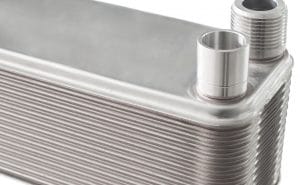 Before heat exchangers became popular, there were few choices in electrical cooling systems, especially for industrial uses. However, as soon as they were first introduced, heat exchangers became popular for giving companies and technology designers a broader choice in thermal management solutions. Since then, heat exchangers themselves have expanded to give companies an even broader range of choices. For example, specific types of heat exchangers, such as cold plates, can be utilized for specific thermal management applications, and even customized to meet each application’s unique cooling needs.
Before heat exchangers became popular, there were few choices in electrical cooling systems, especially for industrial uses. However, as soon as they were first introduced, heat exchangers became popular for giving companies and technology designers a broader choice in thermal management solutions. Since then, heat exchangers themselves have expanded to give companies an even broader range of choices. For example, specific types of heat exchangers, such as cold plates, can be utilized for specific thermal management applications, and even customized to meet each application’s unique cooling needs.
They make thermal management more efficient
While modern heat exchangers come in a wide variety of styles and sizes, they all follow the same basic thermal management concepts to achieve high-performance cooling. That includes the use of an eco-friendly cooling fluid that can efficiently absorb electrical waste heat and transfer it safely away. Within a cold plate heat exchanger, the thin, stacked plates have flow paths machined into them, through which the cooling fluid can easily travel. The design of the plates makes it possible for them to rapidly transfer heat from their surfaces to the cooling fluid within, taking advantage of multiple natural thermal management methods to prevent electrical overheating.
They’re easily customizable for most applications
In addition to streamlining common electrical cooling methods, cold plates are a popular form of heat exchanger for several other important reasons. One of which is their ability to fit into extremely tight spaces while still being able to efficiently handle large amounts of waste heat. The plate design is often ideal for absorbing heat across larger areas (nearly the entire surface of the plate), and when stacked together, the plates can create exponentially more efficient thermal management. This also makes cold plate heat exchangers easily customizable to fit the needs of innovative applications with higher-than-usual thermal management demands.
They’re increasingly more popular in all industries
Because of their high-performance thermal management capabilities and versatility, cold plates have become one of the most popular types of heat exchangers today. Their popular spans across several different industries, and cold plates are often considered the ideal solution for a wide range of varying applications. However, before choosing cold plates, companies should thoroughly research all other forms of heat exchangers to decide if there’s a more appropriate option for their application. For example, heat pipes are also able to achieve high-performance thermal management, and are another of the most popular forms of heat exchangers.
For more information about modern cold plate heat exchangers, call Noren Thermal Solutions in Taylor, TX, at 866-936-6736.







